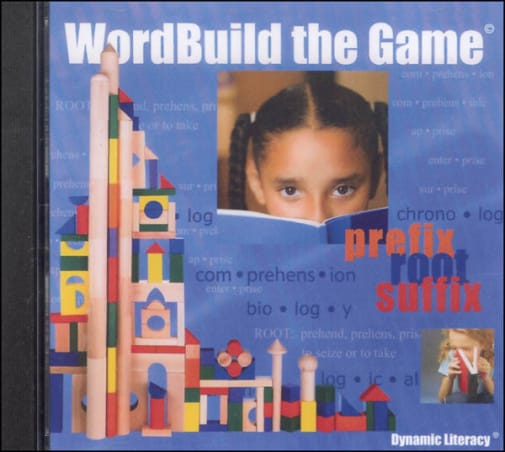While not glitzy, this provides good, root-based practice either as a stand-alone or as a complement to the WordBuild program. Supports up to 99 users, so it can be used with a family and players would each be able to keep track of scores. An interesting aspect is being able to select different music backgrounds (or no music). System requirements: WIN 98 or higher or Mac OS X. Please note this is an older program and might not work well on newer systems.
WordBuild the Game CD
Description
WordBuild the Game is an interactive computer game designed to make morphics based instruction fun! Players select a root and use prefixes and suffixes to string together as many words as they can.
Available for single users or an entire school, this supplemental tool can help build any English speaker's vocabulary. The game's database includes over 18,000 words and the networked version of this game is used in schools across America. The game provides humorous audio feedback, tracks high scores by root, and prints player word lists/score sheets. People who simply love words will find the Game exciting and challenging.
WordBuild teaches students how to build words by first covering prefixes and suffixes in Elements and then examining the common root words in Foundations. Add in instructive interaction coupled with games, grids, and squares, and it’s easy to see why this is the vocabulary program of choice for Analytical Grammar and has been favorably reviewed by Cathy Duffy, Janice Campbell and others. At first glance the program seems a bit pricey, but the quality and effectiveness make it a good value.
The key is the instructive interaction; this program requires more from the teacher but it gives you all the tools. The Teacher Editions are clearly laid out with ready-to-go, daily, detailed lessons that provide what to teach, when to interact with the Student Activity Book, when/what to discuss, and what to demonstrate with the answers right in the lessons. Daily lessons take about 15 minutes, with built-in review and reinforcement. Also included are weekly Check-Ups (Assessments), a Mid-Term and a Final Assessment, and all answer keys. The squares, stair steps, and comprehension questions are all in the Student Activity Book. Each course is considered a one-year course with 36 units.
| Product Format: | Other |
|---|---|
| Grades: | 5-AD |
| Brand: | Dynamic Literacy |
| Length in Inches: | 4.875 |
| Width in Inches: | 5.5 |
| Height in Inches: | 0.25 |
| Weight in Pounds: | 0.1 |

